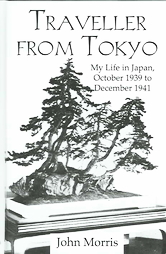Traveller from Tokyo is a first hand account of John Morris’ life in Japan, from pre-World War II through World War II times. The work starts out detailing his arrival as a foreigner in Japan, and his job as an English teacher, educating high schoolers in response to demand for native speakers to teach the language. Morris continues on to explain his search for a suitable house and his difficulties with the Japanese method of street numbering, as well as with procuring a telephone (a rarity in 1930’s Japan). He then digresses and begins to discuss facets of Japanese life, through both his own commentary as well as personal anecdotes. He does so in an organized manner, first discussing everyday Japan (food, dress, and language), then Japanese thought, English and Japanese print, recreational activities, marriage and sex, and finally mass media, including that of the West and its influence on Japan. Part II of the book consists of Morris’ life as a foreigner after December 7th, 1941, the date the Japanese Attacked Pearl Harbor, and entered WWII. This section of the book is less organized, although it does follow Morris’s time in Japan more chronologically. Part II is comprised of sections on Japanese police and criminal proceedings, several personal stories, wartime practices (including rationing and air raid sirens), the Japanese army, and Morris’ departure from Japan after nearly four years.
Traveller from Tokyo is a concise work that covers a broad range of topics. The structure of the book allows the reader to have a ground-level view of Japanese culture, while refraining from taking on an Orientalist perspective. Morris exposes the viewer to Japanese life by picking out facets interesting to Western readers at the time, such as his telephone difficulty: in Japan, it is customary for people to constantly borrow their neighbor’s telephone, since telephones were extremely scarce during the 1930’s. He emphasizes why owning a personal telephone could become such a problem: people would line up in queues down the street waiting to use it! Such glimpses into the author’s life help make the work much more personable.
By discussing events such as dining out, Morris is able to elaborate upon Japanese lifestyle in general. He illustrates customs for Japanese restaurants, as well as their attempts to copy foreign foods. Morris repeatedly writes about the Japanese’s ‘imitation’ of foreign cultures and their adaptations to serve their own needs. He explains how the Japanese have taken foreign foods (chiefly British, French, and American cuisines) and altered them to fit their tastes and preferences. Morris’ chief point is describing how the Japanese are able to assimilate the distinctive traits of other cultures without losing their national identity. The author declines from portraying incorporation in a negative fashion, and thus does not place the West in any superior way to the East, avoiding any ‘Orientalist’ perspective.
Morris also spends a great deal of time explaining the educational system in Japan. After middle school, students that wish to continue their education must take a high school entrance exam and then another for college. The author points out that almost every student’s aim is to secure a government job, which can only be achieved by attending a government-sponsored university. Government jobs are secure, high paying, and will more than pay back the cost of education, and thus attract the interest of well educated students. There is a noticeable difference between the Western and Japanese universities that Morris makes sure to highlight: in Japan, there is no one to regulate the students when away from classes (they are free to do as they please, and have no adult supervision or guidance). The reason for disparity between Western and Japanese students is that Japanese students are more responsible (there have been very few incidents of students causing trouble) and therefore receive more trust from authority than do their Western counterparts. At no point did Morris ever allude to Japan’s inferiority in education, or portray it in a false light; he very carefully avoided any stereotypical or other racist comments that could portray an Orientalist perspective on Japan.
Traveller from Tokyo is concise in its description of everyday Japanese life, and contains a thorough explanation of how the educational system works relative to the books length. The author points out differences between Western culture and that of Japan without placing judgmental criticisms on the Japanese. Unlike many other authors on Eastern culture that attempt to stereotype the Japanese and describe them as inherently different from the West, Morris avoids giving facts based on mere whims and describes things precisely. He does not place his own commentary on things he cannot accurately depict, and evades the typical ‘Orientalist’ perspective found in most works from the era about the East. Rather than coming across as a racist and biased book like many other works of the time, Traveller from Tokyo is informative and contains numerous well-grounded thoughts and ideas. Traveller from Tokyo is an excellent introduction to Japanese culture during and pre-World War II.
